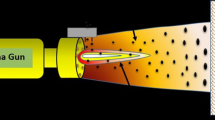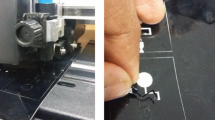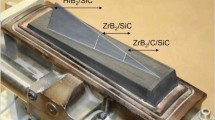Abstract
Conventional chemical propellants such as hydrazine and ammonium perchlorate have been used within the realm of contemporary space propulsion devices and are well established owing to their rich heritage. However, their limitations such as toxicity, difficulty in operational handling and environmental impacts have raised concerns. In view of these limitations, the significance of green propellants such as hydroxylammonium nitrate, hydrogen peroxide (H2O2) and ammonium dinitramide has become more pronounced. In this paper, recent developments in ceramic microthrusters and the associated ceramic microfabrication techniques are reviewed. The characteristics of green propellants are examined, followed by the evaluation of previous attempts to incorporate green propellants into ceramic microthrusters. This has further unveiled the possibilities of green and clean space missions in the future.





Similar content being viewed by others
References
Amrousse R, Katsumi T, Azuma N, Hori K (2017) Hydroxylammonium nitrate (HAN)-based green propellant as alternative energy resource for potential hydrazine substitution: From lab scale to pilot plant scale-up. Combust Flame 176:334–348. https://doi.org/10.1016/j.combustflame.2016.11.011
Anflo K, Mollerberg R, Neff K, King P (2009a) High performance green propellant for satellite applications. In: 45th AIAA/ASME/SAE/ASEE joint propulsion conference & exhibit. American Institute of Aeronautics and Astronautics, Reston, pp 1–13
Anflo K, Moore S, King P (2009b) Expanding the ADN-based monopropellant thruster family. In: 23rd annual AIAA/USU conference and small satellites, pp 1–8
Chaalane A, Chemam R, Houabes M et al (2015) A MEMS-based solid propellant microthruster array for space and military applications. J Phys: Conf Ser 660:12137. https://doi.org/10.1088/1742-6596/660/1/012137
Cheah KH, Chin JK (2011) Performance improvement on MEMS micropropulsion system through a novel two-depth micronozzle design. Acta Astronaut 69:59–70
Cheah KH, Chin JK (2013) Fabrication of embedded microstructures via lamination of thick gel-casted ceramic layers. Int J Appl Ceram Technol. https://doi.org/10.1111/ijac.12023
Cheah KH, Low K-S (2015) Fabrication and performance evaluation of a high temperature co-fired ceramic vaporizing liquid microthruster. J Micromech Microeng 25:15013. https://doi.org/10.1088/0960-1317/25/1/015013
Churaman WA, Morris CJ, Ramachandran R, Bergbreiter S (2015) The effect of porosity on energetic porous silicon solid propellant micro-propulsion. J Micromech Microeng 25:115022. https://doi.org/10.1088/0960-1317/25/11/115022
Courthéoux L, Amariei D, Rossignol S, Kappenstein C (2006) Thermal and catalytic decomposition of HNF and HAN liquid ionic as propellants. Appl Catal B Environ 62:217–225. https://doi.org/10.1016/j.apcatb.2005.07.016
Florczuk W, Rarata GP (2017) Performance evaluation of the hypergolic green propellants based on the HTP for a future next generation spacecrafts. In: 53rd AIAA/SAE/ASEE joint propulsion conference, pp 1–11. https://doi.org/10.2514/6.2017-4849
Gauer M, Telitschkin D, Gotzig U et al (2013) PRECISE—preliminary results of the. In: 49th AIAA/ASME/SAE/ASEE joint propulsion conference, pp 1–13. https://doi.org/10.2514/6.2013-3784
Gotzig U (2015) Challenges and economic benefits of green propellants for satellite propulsion. In: 7TH European conference for aeronautics and space sciences (EUCASS), pp 1–9
Gronland T-A, Westerberg B, Bergman G et al (2006) Reactor for decomposition of ammonium dinitramide-based liquid monopropellants and process for the decomposition. United States Patent 11–21, Patent number: WO2002095207A1
Hitt DL, Zakrzwski CM, Thomas MA (2001) MEMS-based satellite micropropulsion via catalyzed hydrogen peroxide decomposition. Smart Mater Struct 10:1163–1175. https://doi.org/10.1088/0964-1726/10/6/305
Huh J, Kwon S (2014) Design, fabrication and thrust measurement of a micro liquid monopropellant thruster. J Micromech Microeng 24:104001. https://doi.org/10.1088/0960-1317/24/10/104001
Induja IJ, Abhilash P, Arun S et al (2015) LTCC tapes based on Al2O3–BBSZ glass with improved thermal conductivity. Ceram Int 41:13572–13581. https://doi.org/10.1016/j.ceramint.2015.07.152
Jiang B, Maeder T, Santis-alvarez AJ et al (2015) A low-temperature co-fired ceramic micro-reactor system for high-efficiency on-site hydrogen production. J Power Sources 273:1202–1217. https://doi.org/10.1016/j.jpowsour.2014.09.084
Jones DEG, Kwok QSM, Vachon M et al (2005) Characterization of ADN and ADN-based propellants. Propellants, Explos, Pyrotech 30:140–147
Kang H, Lee E, Kwon S (2017) Suppression of hard start for nontoxic hypergolic thruster using H2O2 oxidizer. J Propuls Power 33(5):1111–1117
Karthikeyan K, Chou SK, Khoong LE et al (2012) Low temperature co-fired ceramic vaporizing liquid microthruster for microspacecraft applications. Appl Energy 97:577–583. https://doi.org/10.1016/j.apenergy.2011.11.078
Khaji Z, Klintberg L, Barbade D et al (2016) Alumina-based monopropellant microthruster with integrated heater, catalytic bed and temperature sensors. J Phys: Conf Ser 757:12025. https://doi.org/10.1088/1742-6596/757/1/012025
Khaji Z, Klintberg L, Barbade D et al (2017) Endurance and failure of an alumina-based monopropellant microthruster with integrated heater, catalytic bed and temperature sensors. J Micromech Microeng 27:55011. https://doi.org/10.1088/1361-6439/aa6550
Klapötke TM, Laub HA, Stierstorfer J (2008) Synthesis and characterization of a new class of energetic compounds—ammonium nitriminotetrazolates. Propellants, Explos, Pyrotech 33:421–430
Koh KS, Chin J, Chik TFWK (2013) Role of electrodes in ambient electrolytic decomposition of hydroxylammonium nitrate (HAN) solutions. Propuls Power Res 2:194–200
Köhler J, Bejhed J, Kratz H et al (2002) A hybrid cold gas microthruster system for spacecraft. Sens Actuators A Phys 97–98:587–598. https://doi.org/10.1016/S0924-4247(01)00805-6
Kuan C-K, Chen G-B, Chao Y-C (2007) Development and ground tests of a 100-millinewton hydrogen peroxide monopropellant microthruster. J Propuls Power 23:1313–1320. https://doi.org/10.2514/1.30440
Kundu P, Bhattacharyya TK, Das S (2010) A monopropellant hydrazine MEMS thruster for attitude control of nanosatellites. In: TechSym 2010—proceeding of 2010 IEEE students’ Technology Symposium, pp 137–141. https://doi.org/10.1109/techsym.2010.5469220
Kundu P, Sinha AK, Bhattacharyya TK, Das S (2013) MnO2 nanowire embedded hydrogen peroxide monopropellant MEMS thruster. J Microelectromech Syst 22:406–417. https://doi.org/10.1109/JMEMS.2012.2226929
Kuo B-H (2010) A study on the electrolytic decomposition of han-based propellants for microthruster applications. The Pennsylvania State University
Kuwahara T, Nakagawa I, Hatano H et al (1997) Thermal decomposition characteristics of HAN composite propellant. In: AIAA/ASME/SAE/ASEE JPC. Seattle, WA, pp 1–8
Larsson A, Wingborg N (2011) Green propellants based on ammonium dinitramide (ADN). In: Advances in spacecraft technologies. InTech, Heraklion, Crete, Greece, p 197
Lekholm V, Persson A, Palmer K et al (2013) High-temperature zirconia microthruster with an integrated flow sensor. J Micromech Microeng 23:55004. https://doi.org/10.1088/0960-1317/23/5/055004
London AP, Epstein AH, Kerrebrock JL (2001) High-pressure bipropellant microrocket engine. J Propuls Power 17:780–787. https://doi.org/10.2514/2.5833
Marshall WM, Deans MC (2013) Recommended figures of merit for green monopropellants. In: 49th AIAA/ASME/SAE/ASEE joint propulsion conference, pp 1–13. https://doi.org/10.2514/6.2013-3722
Maurya DK, Das S, Lahiri SK (2005) Silicon MEMS vaporizing liquid microthruster with internal microheater. J Micromech Microeng 15:966–970. https://doi.org/10.1088/0960-1317/15/5/010
Meng H, Khare P, Risha G et al (2009) Decomposition and ignition of HAN-based monopropellants by electrolysis. In: 47th AIAA aerospace sciences meeting including the new horizons forum and aerospace exposition, pp 1–16
Miesse C, Masel RI, Short M, Shannon MA (2005) Diffusion flame instabilities in a 0. 75 mm non-premixed microburner. Proc Combust Inst 30:2499–2507. https://doi.org/10.1016/j.proci.2004.08.140
Negri M (2017) Technology development for ADN-based green monopropellant thrusters—an overview of the Rheform project. In: 7th European conference for aeronautics and space science, pp 1–13. https://doi.org/10.13009/eucass2017-319
Östmark H, Bemm U, Langlet A et al (2000) The properties of ammonium dinitramide (ADN): PART 1, basic properties and spectroscopic data. J Energy Mater 18:123–138
Oxley J, Brower K (1988) Thermal decomposition of hydroxylamine nitrate. Proc SPIE Int Soc Opt Eng 872:63–69. https://doi.org/10.1117/12.943754
Pang W, Fan X, Zhang W et al (2013) Effect of ammonium dinitramide (ADN) on the characteristics of hydroxyl terminated polybutadiene (HTPB) based composite solid propellant. J Chem Sci Technol 2:53–60
Plumlee D, Steciak J, Moll A (2007) Development and simulation of an embedded hydrogen peroxide catalyst chamber in low-temperature co-fired ceramics. Int J Appl Ceram Technol 4:406–414. https://doi.org/10.1111/j.1744-7402.2007.02161.x
Provin C, Monneret S (2002) Complex ceramic-polymer composite microparts made by microstereolithography. IEEE Trans Electron Packag Manuf. https://doi.org/10.1109/TEPM.2002.1000484
Rahman A, Chin J, Kabir F, Hung YM (2017) Characterisation and thrust measurements from electrolytic decomposition of ammonium dinitramide (ADN) based liquid monopropellant FLP-103 in MEMS thrusters. Chin J Chem Eng. https://doi.org/10.1016/j.cjche.2017.09.016
Ranjan R, Karthikeyan K, Riaz F, Chou SK (2018) Cold gas propulsion microthruster for feed gas utilization in micro satellites. Appl Energy. https://doi.org/10.1016/j.apenergy.2018.03.040
Rarata G, Florczuk W, Smetek J (2016) Research on preparation and propulsive applications of highly concentrated hydrogen peroxide. J Aerosp Sci Technol 2:42–47. https://doi.org/10.17265/2332-8258/2016.01.006
Rossi MJ, McMillen DF, Golden DM (1992) Low pressure thermal decomposition studies of selected nitramine and dinitramine energetic materials. Int J Chem Kinet 25:549–570
Rossi C, Do Conto T, Est D (2001) Design, fabrication and modelling of MEMS-based microthrusters for space. SMA 10:1156–1162
Rusek JJ (2004) Hydrogen peroxide for propulsion and power applications: a swift perspective. In: European space agency, (Special Publication) ESA SP, pp 1–7
Sakamoto S, Fujita S, Sugimoto Y, Tanaka N (2017) Mechanical strength of low-temperature co-fired ceramic multi-layered substrate. J Ceram Soc Jpn 125:569–573. https://doi.org/10.2109/jcersj2.125.P6-1
Sun W, Cai G, Donadio N et al (2012) Development of meso-scale co-fired ceramic tape axisymmetric combustors. Int J Appl Ceram Technol 9:833–846. https://doi.org/10.1111/j.1744-7402.2011.00698.x
Tanaka N, Matsuo T, Furukawa K et al (2011) The “greening” of spacecraft reaction control systems. Mitsubishi Heavy Ind Tech Rev 48:44–50
Thakur J, Pratap R, Fournier Y et al (2010) Realization of a solid-propellant based microthruster using low temperature co-fired ceramics. Sens Transducers J 117:29–40
Wernimont E (2006) Monopropellant hydrogen peroxide rocket systems: optimum for small scale. In: 42nd AIAA/ASME/SAE/ASEE joint propulsion conference and exhibit, pp 1–12. https://doi.org/10.2514/6.2006-5235
Wingborg N (2006) Ammonium dinitramide-water: interaction and properties. J Chem Eng Data 51:1582–1586
Wingborg N, Eldsäter C, Skifs H (2004) Formulation and characterization of ADN-based liquid monopropellants. In: European Space Agency, (Special Publication) ESA SP, pp 101–106
Wingborg N, Larsson A, Elfsberg M, Appelgren P (2005) Characterization and Ignition of ADN-Based Liquid Monopropellants. In: 41st AIAA/ASME/SAE/ASEE joint propulsion conference & exhibit. American Institute of Aeronautics and Astronautics, Reston, p 1990
Wingborg N, de Flon J, Johnson C, Whitlow W (2008) Green Propellants Based on ADN. Space Propulsion 2008, 5–8 May 2008, Heraklion, Crete, Greece. ESA, 3AF, SNPE
Wu M-H, Lin P-S (2010) Design, fabrication and characterization of a low-temperature co-fired ceramic gaseous bi-propellant microthruster. J Micromech Microeng 20:85026. https://doi.org/10.1088/0960-1317/20/8/085026
Wu MH, Lu TH (2012) Development of a chemical microthruster based on pulsed detonation. J Micromech Microeng. https://doi.org/10.1088/0960-1317/22/10/105040
Wu MH, Yetter RA (2008) Development and analysis of a LTCC micro stagnation-point flow combustor. J Micromech Microeng. https://doi.org/10.1088/0960-1317/18/12/125016
Wu M-H, Yetter RA (2009) A novel electrolytic ignition monopropellant microthruster based on low temperature co-fired ceramic tape technology. Lab Chip 9:910–916. https://doi.org/10.1039/b812737a
Wu M, Yetter R, Yang V (2008) Development and characterization of ceramic micro chemical propulsion and combustion systems. In: 46th AIAA aerospace sciences meeting and exhibit AIAA 2008-966. https://doi.org/10.2514/6.2008-966
Wu M-Hn, Yetter RA, Yang V (2014) Chemical micropropulsion. In: Cadou YJC (ed) Microscale combustion and power generation. Momentum Press, New York
Yetter RA, Yang V, Wang Z et al (2003) Development of meso and micro scale liquid propellant thrusters. In: 41st aerospace sciences meeting and exhibit
Yuan T, Li A (2009) Design and fabrication of a MEMS-based Milli-Newton level hydrazine thruster. In: 45th AIAA/ASME/SAE/ASEE joint propulsion conference & exhibit. American Institute of Aeronautics and Astronautics
Zhang X, Jiang XN, Sun C (1999) Micro-stereolithography of polymeric and ceramic microstructures. Sens Actuators A Phys 77:149–156. https://doi.org/10.1016/S0924-4247(99)00189-2
Zhang KL, Chou SK, Ang SS (2004) Development of a solid propellant microthruster with chamber and nozzle etched on a wafer surface. J Micromech Microeng 14:785–792. https://doi.org/10.1088/0960-1317/14/6/004
Zhang KL, Chou SK, Ang SS (2005) Development of a low-temperature co-fired ceramic solid propellant microthruster. J Micromech Microeng 15:944–952. https://doi.org/10.1088/0960-1317/15/5/007
Zhang T, Li G, Yu Y et al (2014) Numerical simulation of ammonium dinitramide (ADN)-based non-toxic aerospace propellant decomposition and combustion in a monopropellant thruster. Energy Convers Manag 87:965–974. https://doi.org/10.1016/j.enconman.2014.07.074
Acknowledgements
Funding was provided by Kementerian Sains, Teknologi dan Inovasi (MY) (Grant No. E-Science code: 04-02-12-SF0198).
Author information
Authors and Affiliations
Corresponding author
Rights and permissions
About this article
Cite this article
Markandan, K., Chin, J.K., Cheah, K.H. et al. Recent developments in ceramic microthrusters and the potential applications with green propellants: a review. Clean Techn Environ Policy 20, 1941–1950 (2018). https://doi.org/10.1007/s10098-018-1582-7
Received:
Accepted:
Published:
Issue Date:
DOI: https://doi.org/10.1007/s10098-018-1582-7




